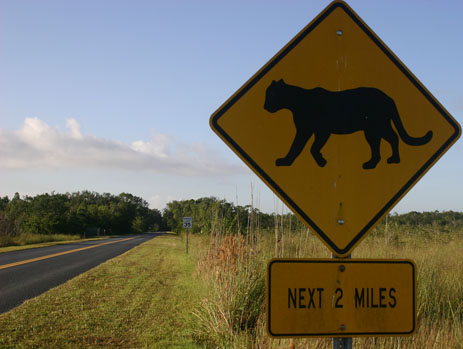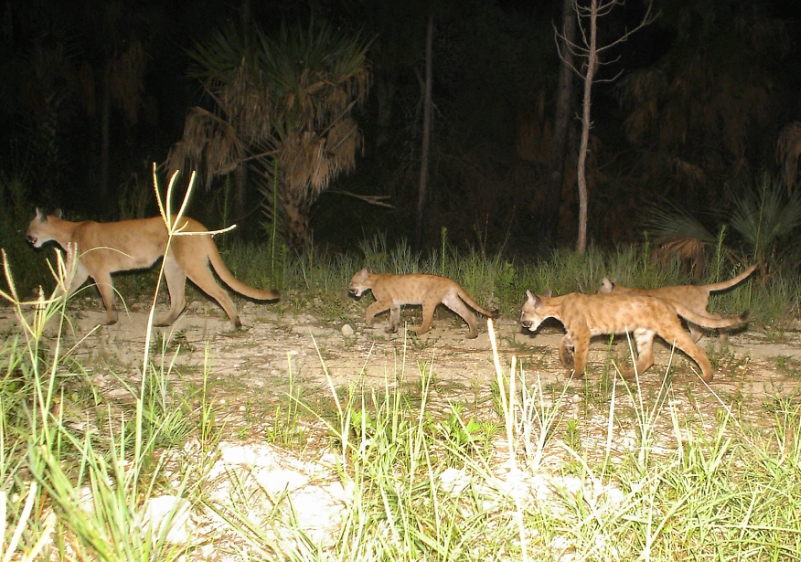When you hear about big cat conservation, it’s often lions in Africa or tigers in India. While lions and tigers deserve all the attention they get, other big cats deserve equal attention, and one of those felines lives right here in Florida: the Florida panther. Let’s discuss this beautiful cat’s current conservation status.
What are Florida panthers?
Florida panthers are similar to cougars (also known as mountain lions, pumas, etc.). In fact, the Florida panther is a separate subspecies of cougar (Puma concolor). Some people argue that panthers are too similar to cougars to be considered a separate subspecies, arguing that they’re classified that way for political reasons. Whatever the case—even if genetic testing causes the U.S. Fish and Wildlife service to classify panthers as just a “distinct population segment” of cougars—they’re likely to remain protected under the Endangered Species Act.
Panthers look almost identical to cougars, their northern, southern and western counterparts. Tan fur, dark ears, yellow eyes and long tail. A large adult female and a small adult male are around 100 pounds each. Many biologists, conservationists and researches consider them the biggest of the “small cats,” but since only lions, tigers, jaguars and some leopards are larger, we consider them a “big cat.”
Where do they live in Florida? How many live in the wild?
They’re most dense in South Florida, places like the northern Everglades, Big Cypress and surrounding areas. That’s where the vast majority of the females live, although a couple recently crossed the Caloosahatchee River, injecting some excitement and optimism in conservationists. Some males have roamed into rural parts of central Florida and perhaps north Florida, but are not breeding there.
There are close to 200 adults in the Florida wild. There’s a margin of error attached to that number, and population estimates usually exclude kittens, some of which grow to adulthood and some of which do not. The Florida Fish and Wildlife Conservation Commission’s goal is to grow the population to either three separate populations of 200+ animals or one continuous population of 600+ animals.
What’s the biggest challenge facing panthers?

Photo courtesy of Fiona Sunquist
In short, roughly 20,000,000 people live in this state, and it’s growing at a rapid rate. With more people comes more development. And with more development comes habitat destruction. Today, while some panthers do pass away from intraspecific aggression (in which animals attack members of their own species), most pass from roadway collisions. Panthers simply need vast, continuous space (see the Florida Wildlife Corridor) to diversify gene pools and find substantial prey bases, and we’re not accommodating those needs as much as we should.
How do panthers benefit the environment?
All apex predators (alpha predators, or at the top of the food chain) contribute to healthy ungulate (hoofed animal) populations. For example, panthers often prey on the old and weak deer, which can help make the stronger even stronger. Besides that, panthers make the wild even wilder. To know a healthy population exists is exciting. To have the potential of seeing one is more exciting. (Don’t be scared if you do spot one; there has never been a documented attack on a human.). And if we can help the cat thrive, it’ll be one heck of a model to help other apex predators thrive.
What’s next?
The federal government will review the big cat’s status. It could remain a separate subspecies and continue to be labeled as “endangered.” Or, it could be considered a normal cougar, yet still get the protection of an endangered species. From there, the state, along with all of the conservation groups fighting for the animal, will either alter or continue with their plans. Plans can include public awareness and education, acquisition of private lands, conservation easements, connecting swaths of land, helping manage panther prey bases and much more.
How can you help?
Reading this article and expanding your knowledge is a start, but there’s much more. Your best bet is to read some more in-depth content, spread the word, and, if you’re able to, donate to the cause. Here are some reputable websites where you can accomplish all of that:
Click here to view previous and current year Florida panther litters, deaths, and depredations.


